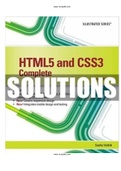www.nursylab.com
www.nursylab.com www.nursylab.com
www.nursylab.com PPT 1.1 HTML5 and CSS3 – Illustrated, 2nd Edition Unit A: Getting Started with HTML A Guide to this Instructor’s Manual: We have designed this Instructor’s Manual to supplement and enhance yo ur teaching experience through classroom activities and a cohesive chapter summary. This document is organized chronologically, using the same heading in dark blue that you see in the textbook. Under each heading you will find (in order): Lecture No tes that summarize the section, Figures and Boxes found in the section, if any, Teacher Tips, and Classr oom Activities and/or Lab Activities. Pay special attention to teaching tips, and activities gear ed towards quizzing your students, enhancing their critical thinking skills, and encouraging experimen tation within the software. In addition to this Instructor’s Manual, our Instructor’s Resources CD also contains PowerPoint Presentations, Test Banks, and other supplements to aid in your teach ing experience. For your students: Our latest online feature, CourseCasts, is a library of weekly podcasts designed to keep your students up to date with the latest in technology news. Direct your stud ents to http://coursecasts.course.com , where they can download the most recent CourseCast onto their mp3 player. Ken Baldauf, host of CourseCasts, is a faculty member of t he Florida State University Computer Science Department where he is responsible for teaching te chnology classes to thousands of FSU students each year. Ken is an expert in the lat est technology and sorts through and aggregates the most pertinent news and informati on for CourseCasts so your students can spend their time enjoying technology, rather than trying to figure it out. Open or close your lecture with a discussion based on the latest CourseCast. TTTaaabbbllleeeooofffCCCooonnnttteeennntttsss
Unit Objectives 2 2: Define a Project Plan 2 4: Create Wireframes and a Storyboard 3 6: Create an HTML Document 5 8: Set Up the Document Head and Body 6 10: Add Text to a Web Page 8 12: Add a Comment to a Web Document 9 14: Preview your Web Page on a Desktop Computer 10 16: Configure Web Server Software 18: Preview Your Web Page on Mobile Devices12 13 End of Unit Material 14 Glossary of Key Terms 14 www.nursylab.com
www.nursylab.com HTML5 and CSS 3 – Illustrated 2nd Ed. Instructor’s Manual: Unit A Page 2 of 15 UUUnnniiitttOOObbbjjjeeeccctttiiivvveeesss
Students will have mastered the material in Unit A when they can: •Define a project plan •Create wireframes and a storyboard •Create an HTML document •Set up the document head and body •Add web page text •Add a comment to a web document •Preview their web page on a desktop computer •Configure a local web server •Preview their web page on mobile devices
222:::DDDeeefffiiinnneeeaaaPPPrrrooojjjeeeccctttPPPlllaaannn
LECTURE NOTES •Define a project plan, also known as a design document, as a document that identifies various aspects of the website, such as goals, objectives and target audience , and explain the importance of preparing a project plan. •Explain that in order to identify the goals and objectives of a website, the website designer must ask a variety of questions regarding the client's goals, objectives, expec tations, and target audience. Give examples for such questions. •Show students how websites that are directed to different audien ces look different, and explain that this is the reason it is important to understand who the target audi ence is prior to planning the design of a website. Give examples of questions that can be asked in order t o identify the target audience: questions identifying users, such as gender and age range ; questions identifying user's needs, such as why they will be visiting the website; and questions ide ntifying user's technological tools, such as the type of operating system they use or the screen resolu tion at which they will be viewing the website. •Stress that it is important to ask questions in the design phase even if you know the client won't have ready answers to most of the questions, because even having some information can greatly assist in planning a user-friendly website. •Explain to students that websites usually have one or two main fun ctions, and give examples, such as serving as an online informational brochure, providing infor mation for special interest groups, showcasing examples of different types of works and designs, providing mu ltiple levels of information with templates, extracting information from database s or conducting business transactions through the Internet. •Stress the importance of identifying the type of website a client wants as a method for identifying the scope of the project. Explain that it is important to define wha t the site will include, as well as what the site won't include. •Note that based on the expected scope of the project and prior to d oing any work, a website designer should develop a budget, which will be included in the project plan and will become part of the contract with the client. www.nursylab.com
www.nursylab.com




